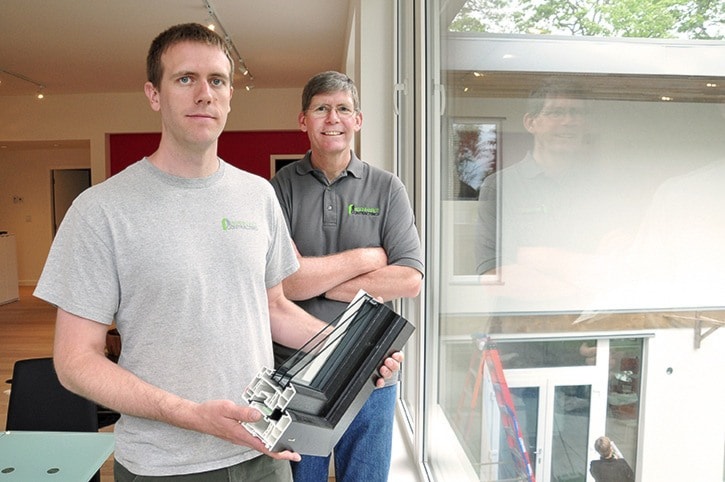With more windows than walls peering on towering oak trees in the backyard, Mark Bernhardt’s house doesn’t look like a hermetically sealed vault.
Yet in terms of heat retention, this is one of the most air-tight and energy efficient residential buildings in North America. Windows and windowed exterior doors are triple-paned, gasket sealed and insulated. Its walls are twice as thick as a conventional house.
“This is our furnace here,” says Mark, pointing to the oversized south-facing windows that allow sunlight to stream in for most of the day.
“That is the first thing you’ll notice – big windows on the south side and small on the north. The doors are more like vault doors – a tight seal with no draft,” adds Rob Bernhardt, the project manager and Mark’s father. “There is high solar heat gain. It lets the sun in and the heat can’t get out.”
Mark, 30, and Rob, 60, have designed and built Greater Victoria and Vancouver Island’s first “passive house.” It’s a building they hope will meet the standard of the International Passive House Association. It should cut heating costs by 90 per cent, primarily through its design, orientation and insulation.
“I needed a house. Rather than do the ordinary thing, I came across (passive homes),” says Mark, a commercial building general contractor. “This made sense from an economic standpoint. It’s not a more expensive house to build.”
A critical element alongside the highly insulated, nearly air-tight building envelope is its high-performance air ventilation system, which warms incoming fresh air with outgoing used air through a heat exchange.
“Modelled heating costs for this house come in at $168 per year,” Mark says. “My current house I paid $400 in December alone with a high-efficiency gas furnace.”
In June, the Bernhardt clan will move into the 3,800-square-foot home at 1535 Oak Crest Dr. in Saanich – Mark and his family upstairs and his parents in the legal lower suite – after appliances are installed and tours are finished. The original home on the property was trucked to a new location in Langford.
The Bernhardts have given civic leaders, property developers, engineers and real estate agents home tours to show that innovative “green” houses aren’t difficult to build and can be done for about the same price as a modern home.
The passive house cost about $740,000 versus about $710,000 for a comparable wood frame building, according to the Bernhardt’s cost breakdown. Framing, insulation and windows cost more, but savings came with heating and air management systems, instead of a furnace or baseboard electric. Far lower monthly energy costs are expected to offset the higher mortgage cost.
“With high-quality windows and doors, there’s no draft and even temperatures through the house,” Rob says. “You spend more on windows and doors, you spend less on the heating system.”
The house is plumbed for solar panels, photovoltaics and solar hot water, although Mark says the energy cost savings at this point would be negligible. A 100-square- feet of solar panels would take the “house off the grid,” he says.
Green City Solutions, a non-profit firm that worked with the Bernhardts on energy modelling, expects the Saanich home to easily exceed the International Passive Home standards.
Torsten Ely, Green City’s building energy analyst, expects to finish efficiency testing on the house this week or next. Ely oversaw “blower” testing on the building before the drywall went up, which over and under-pressurizes the home to gauge air leakage.
A typical post-Second World War house in Victoria has enough cumulative leaks and cracks to form a hole 45 centimetres in diameter. A modern house would have a hole on the order of 30 to 35 cm. Ely said the Bernardt’s house had the equivalent leakage of a 5.5 cm hole.
“This would make the house the second most air-tight in North America,” Ely said. The most air-tight is in New Brunswick. “There is good reason to believe the final tests will be better.”
Peter Sundberg, the executive director of Green City Solutions, said in terms of other “green” building standards, such as BuiltGreen and LEED for homes, passive home design is about as good as it gets.
“Each program has its place ... but passive homes are among the pinnacle of energy efficient homes. It’s great to see this happening,” Sundberg said.
“This house is significantly more efficient than new homes built to code. This is a new breed of super-efficient homes.”
Sundberg also noted that the passive house construction process is well within the ability of most developers and trades in Greater Victoria. There’s been a general assumption from developers and the home-buying public that high efficiency homes are extremely expensive and technically difficult, he said.
“Passive home is a high standard, but its definitely an achievable standard that many developers in Victoria could build, if there was a demand.”
See bernhardtpassive.com.
editor@saanichnews.com
